How Planning School Bus Conversion Ideas Helps Save Money

Before beginning our build, we found that planning school bus conversion ideas before buying any materials could save time and money while reducing waste. Unlike being chained to a home mortgage for the next 20-30 years, our vision was that we could reduce our debt by living in a tiny home on wheels. I think we’re on to something!
Today’s article is about how we took our school bus conversion ideas and planned them out to save money.
AFFILIATE DISCLOSURE: Note that we are affiliated with products and services we use and trust. If you click a link and make a purchase, we’ll earn a small commission at not extra cost to you. This helps us to continue producing content and we hope that you use our links if our blog posts or videos have helped you in any way!
School Bus Conversion Idea Considerations
After we bought our school bus to convert into a motorhome, we needed to consider all of our bus conversion ideas. Every idea lead down a rabbit hole of questions on feasibility & implementation.
One of the big questions we had before starting our bus conversion project was, “How do we plan our bus conversion ideas?”
While researching, we noticed that instead of looking at the big picture of the bus conversion as a whole, we had to break down all of our ideas into smaller projects. It was that defining moment that provided clarity to us being able to create an organized plan.
To eliminate confusion and become purposeful with all our school bus conversion ideas, we started to map out all of our ideas to take into consideration.
Erin could not wait to get on the bus and start doing her interior design. So she grabbed her Moleskin Journal and started to sketch out potential floor plans. While she did that, I would take her inspiration and look for ways to reduce the build’s weight while persevering the esthetic of her skoolie interior designs.
I was more interested in creating a systematic plan to save time, eliminate wasted material cost, and create a beautiful tiny home on wheels that would take us down the road safely, in comfort.
Planning school bus conversion ideas boil down to what needs to be done in what order so that we don’t have to back-peddle and can continue to make forward progress.
Roughing Out A Skoolie Floor Plan
In our School Bus Conversion Guide article, we talk about the different areas that we’re building on our school bus. Part of the bus conversion ideas that have popped up revolves around the floor plan.
What’s drawn on paper doesn’t always work out in real life. Before buying our bus, we had drawn out a half dozen skoolie floor plan ideas, and most of them didn’t work in real life.

We didn’t know the exact dimensions of the interior, the location of wheel wells, the height of the ceiling, or even the curve from the walls to the roof. Although sketching out ideas is helpful, we didn’t finalize our skoolie floor plan until we bought our bus in Phoenix, Arizona.
Once we bought our bus, we could take the conversion ideas from our preliminary sketches and see which parts would work and which ideas we needed to ditch.
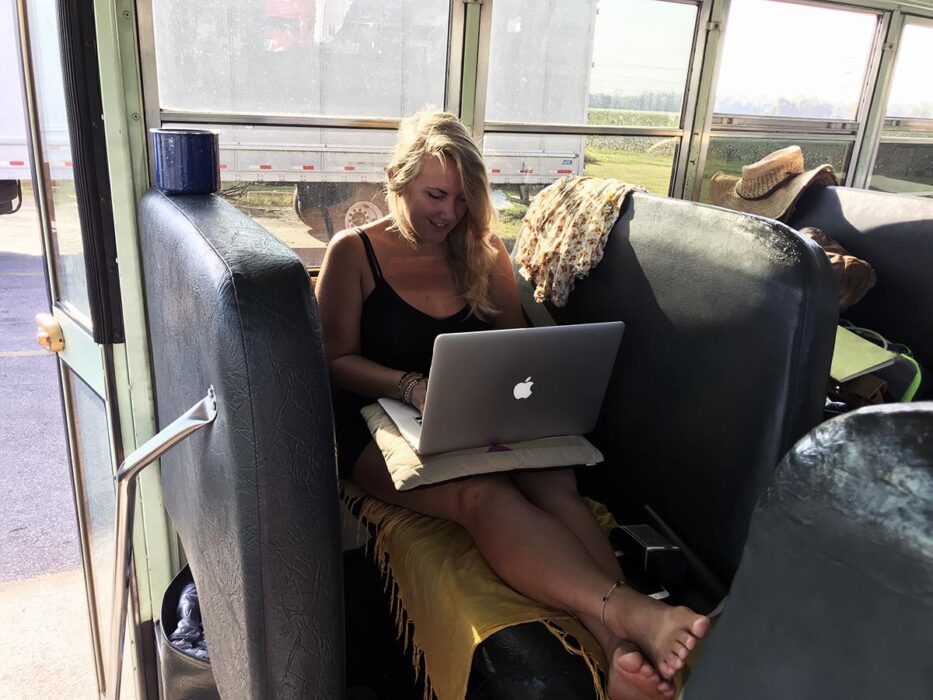
Little did we know that as we were building, the floor plan would continue to evolve into something that would indeed be unique.
If we were to do this all over again, we would start with deciding where the drains would be in the floor because that alone will change where things like the sinks, composting toilet, and shower would end up. Regardless, everything is figure-out-able!
Want our used school bus visual inspection form? Get It Free
Climate Considerations
There are two main climates to consider when bringing any school bus conversion idea to reality. Those climates are hot and cold (all the in-between environments don’t affect livability as much.)
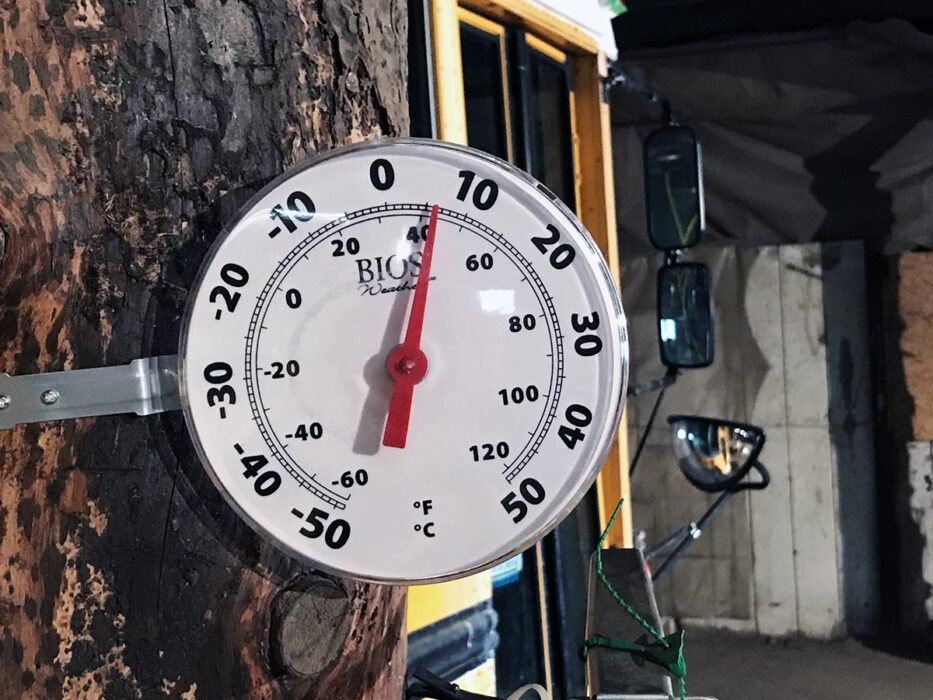
In hot climates, ventilation is critical, while in cold temperatures, keeping the cold out and the hot in is essential to a comfortable tiny home on wheels.
Questions we asked ourselves around skoolie build climate considerations:
- What climate region do we plan on boondocking our skoolie primarily?
- Are we going to have air conditioning or stick with natural ventilation?
- What will be our heat source (and will there be a backup)?
- How many skylights are we going to need?
- Will the outdoor shower need hot water or just cold?
- What kind of insulation is best for a school bus conversion?
There are many more considerations for climate-based decisions for converting a school bus into a motorhome. However, the questions that were most pressing for us are the ones that mean the difference between being comfortable or miserable (we like the idea of being comfortable).
Making a list of our questions helped to decide on building materials and components for installation.
Skoolie Plumbing – Water flows downhill
Now that we have come up with a particular floor plan that seems to check all the boxes on ergonomics, utility, and comfort, now we start looking at other systems such as plumbing.
Considering we were not going to have a bucket under the sink for the gray water catchment as we did in our pre-conversion for our title loophole, all the drains needed to find their way under the bus and into the gray water tanks, somehow.
We are not planning on having a black water tank, eliminating the need for a big diameter pipe required for moving turds & TP through plumbing systems.
Gray water tanks only need 1 ½” ABS drain pipes. What’s cool is that the space we allotted in the walls is more than enough to run lines behind. We chose to use ABS drain pipes because ABS can handle more shock without cracking than PVC.
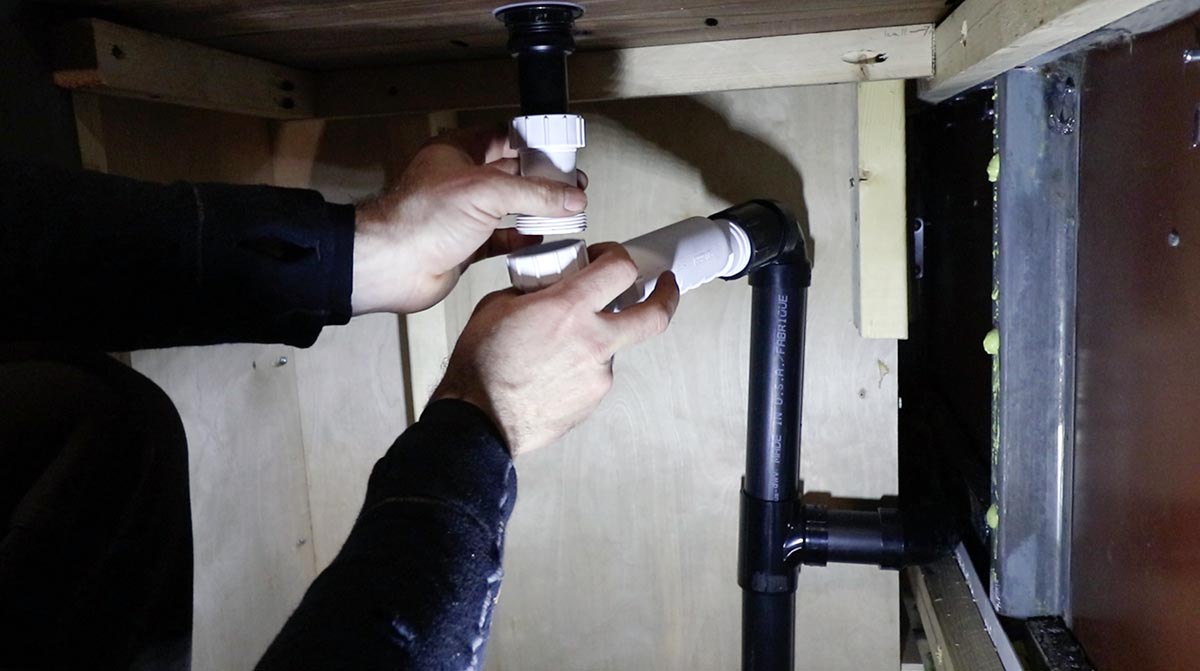
In residential plumbing, the standard for drainage in most places worldwide is ¼” drop for every 12” run, which equates to 1” every 4’.
Now that we have the drains sorted out, water lines are a consideration too! There are many sizes of water pumps. First, we figured out the maximum amount of gallons per minute (GPM) we would be running if someone was in the shower and someone else was washing dishes. Most faucets have those specifications available. All we did was add up the total GPM to determine the water pump size we would need at a minimum to prevent low pressure while two faucets were running at once.
The next consideration for plumbing was what type and size of water lines would be best. There are numerous sizes of waterlines, and the bigger the line, the more water it can carry. Waterline size is important because we have a limited amount of freshwater to use.
When calculating water line size, consider the total volume of water that can be carried by the waterline’s different diameters along with your maximum GPM the water pump can produce. After running some calculations, we figured out that using ½” water lines for both cold and hot water would be best as it was a nice size for our total flow and the pump we went with.
Skoolie Off-Grid Energy Considerations (for when SHTF)
Once our bus conversion is complete, we plan on taking to the roads, exploring remote areas, and filming documentaries on self-reliance. With our travels, there are several energy sources that we could use. However, we plan on limiting the number of energy sources we use because when SHTF (Shit Hits The Fan), the more energy sources that are built into a school bus conversion, the more difficult it will be to hunt each one of them down.
- Electricity is one of the most widely used energy sources as it can be used for cooking, heating, cooling, and charging devices. To harness electricity off-grid, it can be produced by capturing solar energy, running a generator, harvesting wind power, or even putting a Pelton wheel into the water and generating electricity that way.
- Propane can be used for cooking, heating and producing electricity via a generator.
- Gasoline is popular for electricity generators and some short school buses use it to power their engines.
- Last is diesel, which is used in our school bus engine and can be used in a diesel generator to produce electricity.
As you can see, there are several school bus conversion ideas to choose from in regards to energy.
We decided to limit our energy to two sources:
- Electric
- Diesel
Using solar panels, we will capture the sun’s rays and convert them into electricity. The problem with solar energy is that if it’s cloudy out, or we’re parked in the shade, the panels won’t be able to capture as much sunlight, which decreases solar energy production.
In the future, we also look forward to experimenting with hydroelectricity using a Pelton waterwheel generator. This could be a little device that we set in a flowing stream. When the water runs through it, a waterwheel spins creating an electric current that we could have hooked up to our bus charge controller.
Our skoolie is powered by diesel, so when we add a generator to our systems, it will most likely be diesel-powered so that we can limit the number of different fuels we need to operate. What’s cool about diesel is that it is widely used in the transportation industry so if SHTF, it might still be available so the supply chain is not disrupted too much.
We’re also going to be using diesel-powered cab heaters. With these, we’ll be able to heat our skoolie with diesel, and it happens to be a very efficient fuel when it comes to heating compared to other sources of energy.
There is no perfect situation for energy sources, especially in a SHTF scenario. So choosing fuel types, or better yet, limiting the number of fuel types needed to live comfortably is important!
Cell Signal & Internet Connectivity In A Skoolie
Part of the planning process that can be easily missed is cell signal and internet connectivity in a skoolie. We take for granted that we always can pick up our phone to make a call or Google a question to get an answer.
However, while we were traveling, before we started our skoolie project, often, we were left with a brick of a smartphone in our hands as there was not a cell phone or internet connection available. If you’re anything like us, we still have to work to earn an income. Our work is usually done online producing films or building websites, which requires an internet connection.
Times we’re creating art pieces for sale don’t require an internet connection, but might once we need to publish pictures or put up a product listing of the piece.
There are ways to combat this lack of cell signal and internet connectivity in a skoolie.
The most obvious way is to drive to a location where a signal can be picked up.
Another way is to install signal boosters on your rig. Cell phone signal boosters like this one, use a directional antenna to capture a faint signal in the distance and boost it so that it’s useable. However, with all signal boosters, if there is no signal present, then there will be nothing to boost.
School Bus Conversion Bare Necessities
When it comes to school bus conversion ideas, sometimes getting back to the bare necessities can bring focus to a build. What is absolutely needed in a build varies from person to person. Consequently, the bare necessities for one person may be different than another.
For our school bus conversion, the bare necessities are:
- No leaks in the roof
- Freshwater
- Electricity
- Kitchen equipped for cooking meals
- Bathroom with a composting toilet & a shower
- A comfy bed & livingroom
Everything past those things is over and beyond. Also, things added above and beyond to the bus conversion can be considered a want versus a need. An example of this would be building our own composting toilet versus buying a manufactured composting toilet. The difference between the two is about $800. Regardless, a $5 bucket and a $1,000 bucket will both catch a turd.
Dreamy Dreams (Needs vs. Wants)
While planning our school bus conversion ideas, we went a step further by labeling if an idea is a need or a want. By putting every idea on a big whiteboard, both Erin and I went on a jam session with organizing all the components that would make our lives easier in one way or another.

Some of the items on our whiteboard we would label a need, like a kitchen countertop, for instance. However, a want would be for us to build it out of live edge wood. We could probably go out and find a really inexpensive countertop that would work fine in the kitchen, but if the opportunity arose to find some live edge wood, we would prefer taking the extra time to build the countertop to our exact specifications.
It’s good to dream of the best-case scenario when toying with bus conversion ideas because that lends to increasing creativity to build the space exactly how we want it. Even though we wanted to finish our skoolie build super-fast, we wanted to make sure that it was built sturdy so that it would last.
Upcycling Materials To Save Money
Being that the idea of building a skoolie is to save money, although, at times it’s unavoidable to buy new components, we work our best to upcycle what’s old and make new. Using materials that have been either tossed out on the side of the road or re-using materials that we found in online classifieds, we’re doing our part to breathe new life into old stuff.
An example of upcycling materials is our reclaimed barn wood floor. When we were researching wood floors, all we found was manufactured or engineered wood floor material. That wasn’t going to cut it for us. So we found some available century-old barn wood that was going to be torn down and carefully procured it to turn into what is now our floor.

Other materials we’ve upcycled are the majority of the 2x4s that we used for our furring strips and framing walls. We were able to take apart some old barn platforms, remove the old nails and screws, followed by re-using the boards for part of our construction.
To upcycle materials, we frequently search on the various online marketplaces or head out to a Goodwill ReStore to see what is available. Often, we find the stuff we didn’t know we needed or get ideas about what we could use for various projects.
Realistic Bus Conversion Timeline
We bought our school bus in September of 2019. Right out of the gate I had this grandiose idea that we’d be done in about three months. As of this writing in January 2021, we are now almost a year and a half into our build with no end in sight.
That begs for the question, “What is a realistic bus conversion timeline?”
The answer is different for everyone because it goes back to needs vs. wants as well as bare necessities. Even though whipping out our bus conversion sounded like a great idea, once we started doing demolition and changing plans for what we wanted to do, the timeline began changing.
Inevitably, projects will take longer to do because they might be more challenging to complete or they take longer because we had to learn new skills. Another reason our build is taking as long as it has is that we are filming and editing the videos as we go for our YouTube channel. That alone is a full-time job and we’re packing the time it takes to complete a bus conversion on top of it!
So, could we have finished in three month? Yeah, probably.
But would we have built the bus exactly how we wanted it? No, probably not.
It’s a give and take.
Learning New Skills To Reduce Costs
Building skills and building knowledge is probably the biggest barrier to completing a bus conversion project the way we are doing it. One thing we’re happy about is that both Erin and I are more than eager to learn a new skill, like welding and metalwork.
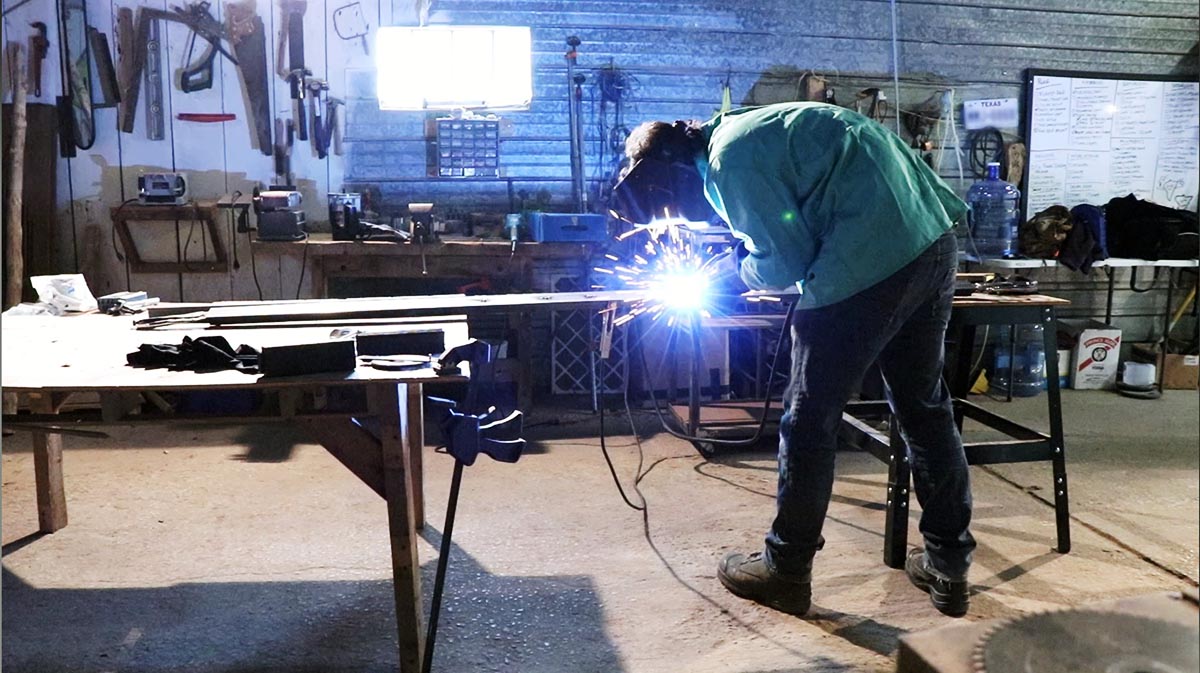
Just knowing how to work with metal has made projects that were previously unattainable a reality.
Various skills we’ve had to use to build our skoolie include:
- Carpentry
- Metalwork
- Electrical work
- Plumbing
- Diesel engine work
- Drafting plans
The big takeaway for us is that if there is something that we need to be done, we’re not shy to figure out what we need to do to bring it to fruition.
In Conclusion
Planning school bus conversion ideas can save a lot of time, money, and headache. Instead of viewing our entire conversion as one big project, mentally it helps to break the entire project up into smaller projects. Doing this produces a definite starting and stopping point for each project, which gives us benchmarks to view along the way.
What things do you think would help to make planning a school bus conversion more efficient? We’d love to know in the comments below.

Until Next Time… Adventure On!
– Brian Garcia
Hey, we're Brian + Erin. Currently, we're workin' on our bug out bus. Lucky the proverbial $hit hadn't hit the fan yet when we picked up this 40-foot beauty in Phoenix AZ and drove it up to Canada to convert it. Hopefully, we all still have time...
Honestly, this bus conversion has been the only sane thing in this insane world lately. We can't tell you how good it feels to BE working on something that lights our souls up and has such potential for a life that is entwined with nature, love, and happiness.
Our main goal is to inspire people to get off-grid and become self-reliant. We are well on our way and are super excited to talk about solutions with others who are shooting for a similar way of living.
Did This Blog Post Help You? If so, we would greatly appreciate it if you comment below and share it with a friend.
Check out our must-read articles about Skoolie Conversion
Texas Couple Accidentally Won School Bus Auction | Registering & Building A Skoolie In DFW
Joeseph & Jennifer Davis from DFW, Texas accidentally won an online auction to buy a school...
DIY Skoolie Solar System To BE Off-Grid Longer
When designing & building a DIY skoolie solar system, there are quite a few considerations....
Steps To Import A Bus From The USA To Canada (Or Vice Versa)
Yvan & Sylvie from Québec have successfully imported not just one, but TWO buses from the USA...

BE Adventure Partners guides people in making money online. Earn an independent living from your knowledge, skills & passions. Become self-reliant. Live a smart & simple life on your terms.
LEARN WITH BEAP
Get Your Skoolie On
FREE On Demand Training Class
eCourse Library
Member Login




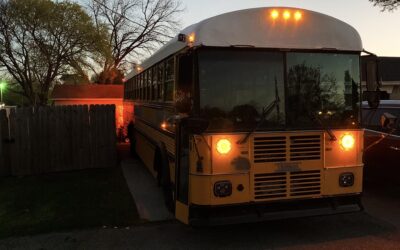
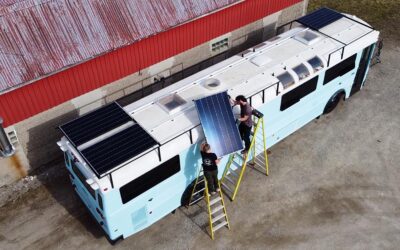
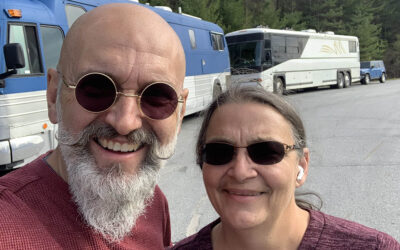
I’ve really enjoyed reading your blogs. I down received your check list, thank you.
Hey there Allison! We’re happy you enjoy our articles. Enjoy the checklist and please let us know if you have any questions. Happy travels! – Brian + Erin